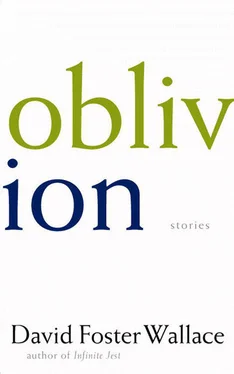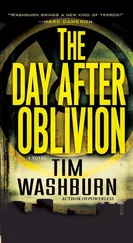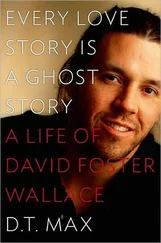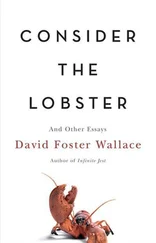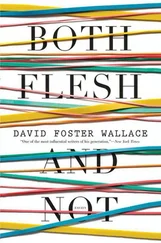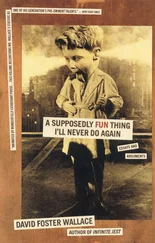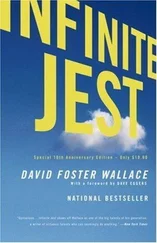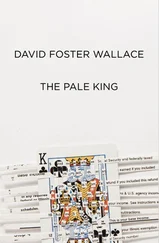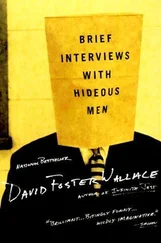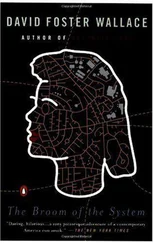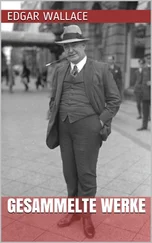The crowd on the sidewalk’s growth was still inconstant. For every two or three passersby who joined the group of onlookers craning upward, someone else in the crowd suddenly looked at his watch and detached from the collective and hurried off either northward or across the street to keep some type of appointment. From a certain perspective the small crowd, then, looked like a living cell engaged in trade and exchange with the linear streetside flows that fed it. There was no evidence that the climbing figure saw the fluctuantly growing mass so far below. He certainly never made any of the motions or expressions people associate with someone at a great height looking down at them. No one in the sidewalk’s group of spectators pointed or yelled; for the most part they just watched. What children there were held their guardians’ hand. There were some remarks and small conversations between adjoining onlookers, but these took place out of the sides of their mouths as all parties looked up at what appeared to be a sheer and sky-high column of alternating glass and prestressed stone. The figure averaged roughly 230 seconds per story; a commuter timed him. Both his backpack and apron looked full of some kind of equipment that caused them to bulge. There were loops along his GoreTex top’s shoulders and also — unless it was a trick of the building’s windows’ refracted light — small strange almost nipplelike protuberances at the figure’s shoulders, on his knees’ backs, and in the center of the odd navy-and-white bullseye design at the figure’s seat. The crampons on mountaineering boots can be removed with a small square tool so that they can be sharpened or replaced, a long-haired man supporting an expensive bicycle against his hip told the people around him. He personally felt he knew what the protuberances were. New members of the crowd always asked the people around them what was going on, whether they knew anything. The costume was airtight, the guy was inflatable or designed to look that way, the long-haired man said. He appeared to be talking to his bicycle; no one acknowledged him. His pantcuffs were clipped for easy cycling. On every third or fourth floor, the figure paused for a time on his back on the narrow ledge with scrollwork at the cornices, resting. A man who had at one time driven an airport shuttlebus opined that the figure on the ledge looked to be purposely idling, timing out his ascent to conform to some schedule; the child attached to the hand of the woman he said this to looked briefly over at him with his face still upturned. Anyone looking straight down would have seen a shifting collection of several dozen watching faces with bodies so foreshortened as to be mere suggestions only.
‘Probably only up to a certain point,’ Terry Schmidt said then in response to a sort of confirmational question from the tall man with the kite-shaped face and a partly torn tag (two of the room’s six cursive nametags were ripped or sectional, the result of accidents during their removal from the adhesive backing) that read FORREST, a 40ish fellow with large and hirsute hands and a slightly frayed collar, whose air of rumpled integrity — along with two separate questions that had actually helped advance the presentation’s agendas — made this fellow Schmidt’s personal choice for foreman. ‘What it is is just that R.S.B. feels your Focus Group responses qua group instead of just as the sum of your personal individual responses is an equally important market research tool for a product like the Felony!. “GRDS as well as IRPs” as we say in the trade,’ with a breeziness he did not feel. One of the younger members — age 22 according to the tiny Charleston code worked into the scrollwork at his nametag’s lower border, and handsome in a generic way — wore a reversed baseball cap and a soft wool V-neck sweater with no shirt underneath, displaying a powerful upper chest and forearms (the sleeves of the sweater were carefully pushed up to reveal the forearms’ musculature in a way designed to look casual, as if the sweater’s arms had been thoughtlessly pushed up in the midst of his thinking hard about something other than himself), and had crossed his leg ankle-on-knee and slid so far down on his tailbone that his cocked leg was the same height as his chin, thereupon holding the salient knee with his fingers laced in such a way as to apply pressure and make his forearms bulge even more. It had occurred to Terry Schmidt that even though so many home products, from Centrum Multivitamins to Visine AC Soothing Antiallergenic Eye Drops to Nasacort AQ Prescription Nasal Spray, now came in conspicuous tamperproof packaging in the wake of the Tylenol poisonings of a decade past and Johnson & Johnson’s legendarily swift and conscientious response to the crisis — pulling every bottle of every variety of Tylenol off every retail shelf in America and spending millions on setting up overnight a smooth and hassle-free system for every Tylenol consumer to return his or her bottle for an immediate NQA refund plus an added sum for the gas and mileage or US postage involved in the return, writing off tens of millions in returns and operational costs and recouping untold exponents more in positive PR and consumer goodwill and thereby actually enhancing the brand Tylenol’s association with compassion and concern for consumer wellbeing, a strategy that had made J. & J.’s CEO and their PR vendors legends in a marketing field that Terry Schmidt had only just that year begun considering getting into as a practical and potentially creative and rewarding way to use his double major in Descriptive Statistics + Bv. Psych, the young Schmidt imagining himself in plush conference rooms not unlike this one, using the sheer force of his personality and command of the facts to persuade tablesful of hard-eyed corporate officers that legitimate concern for consumer wellbeing was both emotionally and economically Good Business, that if, e.g., R. J. Reynolds elected to be forthcoming about its products’ addictive qualities, and GM to be upfront in its national ads about the fact that vastly greater fuel efficiency was totally feasible if consumers would be willing to spend a couple hundred dollars more and settle for slightly fewer aesthetic amenities, and shampoo manufacturers to concede that the ‘Repeat’ in their product instructions was hygienically unnecessary, and Tums’ parent General Brands to spend a couple million to announce candidly that Tums-brand antacid tablets should not be used regularly for more than a couple weeks at a time because after that the stomach lining automatically started secreting more HCl to compensate for all the neutralization and made the original stomach trouble worse, that the consequent gains in corporate PR and associations of the brand with integrity and trust would more than outweigh the short-term costs and stock-price repercussions, that yes it was a risk but not a wild or dicelike risk, that it had on its side both precedent cases and demographic data as well as the solid reputation for both caginess and integrity of T. E. Schmidt & Associates, to concede that yes gentlemen he supposed he was in a way asking them to gamble some of their narrow short-term margins and equity on the humble sayso of Terence Eric Schmidt Jr., whose own character’s clear marriage of virtue, pragmatism, and oracular marketing savvy were his best and final argument; he was saying to these upper-management men in their vests and Cole Haans just what he proposed to have them say to a sorry and cynical US market: Trust Me You Will Not Be Sorry — which when he thinks of the starry-eyed puerility and narcissism of these fantasies now, a rough decade later, Schmidt experiences a kind of full-frame internal wince, that type of embarrassment-before-self that makes our most mortifying memories objects of fascination and repulsion at once, though in Terry Schmidt’s case a certain amount of introspection and psychotherapy (the latter the origin of the self-caricature doodling during downtime in his beige cubicle) had enabled him to understand that his professional fantasies were not in the main all that unique, that a large percentage of bright young men and women locate the impetus behind their career choice in the belief that they are fundamentally different from the common run of man, unique and in certain crucial ways superior, more as it were central, meaningful — what else could explain the fact that they themselves have been at the exact center of all they’ve experienced for the whole 20 years of their conscious lives? — and that they can and will make a difference in their chosen field simply by the fact of their unique and central presence in it. .; and but so (Schmidt also still declaiming professionally to the TFG all this while) that even though so many upmarket consumer products now were tamperproof, Mister Squishy-brand snack cakes — as well as Hostess, Little Debbie, Dolly Madison, the whole soft-confection industry with its flimsy neopolymerized wrappers and cheap thin cardboard Economy Size containers — were decidedly not tamperproof at all, that it would take nothing more than one thin-gauge hypodermic and 24 infinitesimal doses of KCN, As 2O 3, ricin, C 21H 22O 2N 2, acincetilcholine, botulinus, or even merely Tl or some other aqueous base-metal compound to bring almost an entire industry down on one supplicatory knee; for even if the soft-confection manufacturers survived the initial horror and managed to recover some measure of consumer trust, the relevant products’ low price was an essential part of their established Market Appeal Matrix *, and the costs of reinforcing the Economy packaging or rendering the individual snack cakes visibly invulnerable to a thin-gauge hypodermic would push the products out so far right on the demand curve that mass-market snacks would become economically and emotionally untenable, corporate soft confections going thus the way of hitchhiking, unsupervised trick-or-treating, door-to-door sales, & c.
Читать дальше
